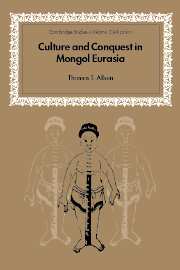Book contents
21 - Filtering
Published online by Cambridge University Press: 04 September 2009
Summary
The Mongols' propensity to borrow from subject peoples, while certainly extensive, was neither unbounded nor open-ended. The state culture they fashioned consisted of three basic components: the indigenous traditions and institutions of conquered peoples, foreign traditions imported by the Chinggisids and, finally, the Mongols' own social and cultural norms. This component is usually downplayed, but should not be overlooked in the study of Mongolian governance or of trans-Eurasian cultural exchange. The long-established cultural categories of the Mongols and their closest allies, such as the Uighurs, acted as filtering devices that selected what was to be appropriated, apportioned, and transmitted. Like all peoples, the Mongols tended to select those items which were compatible with their native traditions, a process that placed some restrictions on borrowing but in the main was quite flexible. Even in the realm of high literary culture and science the Mongols found functional equivalents that complemented rather than displaced elements of their own culture.
In this chapter we will explore the filtering mechanisms at work in the Mongols' appropriation of medicine, astronomy, geography, and cartography from sedentary cultures. These disciplines, at least in terms of goals, were quite compatible with the practice of shamanism; their methods differed radically but in their quests for cures, for knowledge of the future, for charting the powers of nature, the Mongols found ready analogies in their own cultural schema. To understand the reasons for these equations, we must first look into the types and functions of Mongolian shamans of the thirteenth century.
- Type
- Chapter
- Information
- Culture and Conquest in Mongol Eurasia , pp. 203 - 209Publisher: Cambridge University PressPrint publication year: 2001

